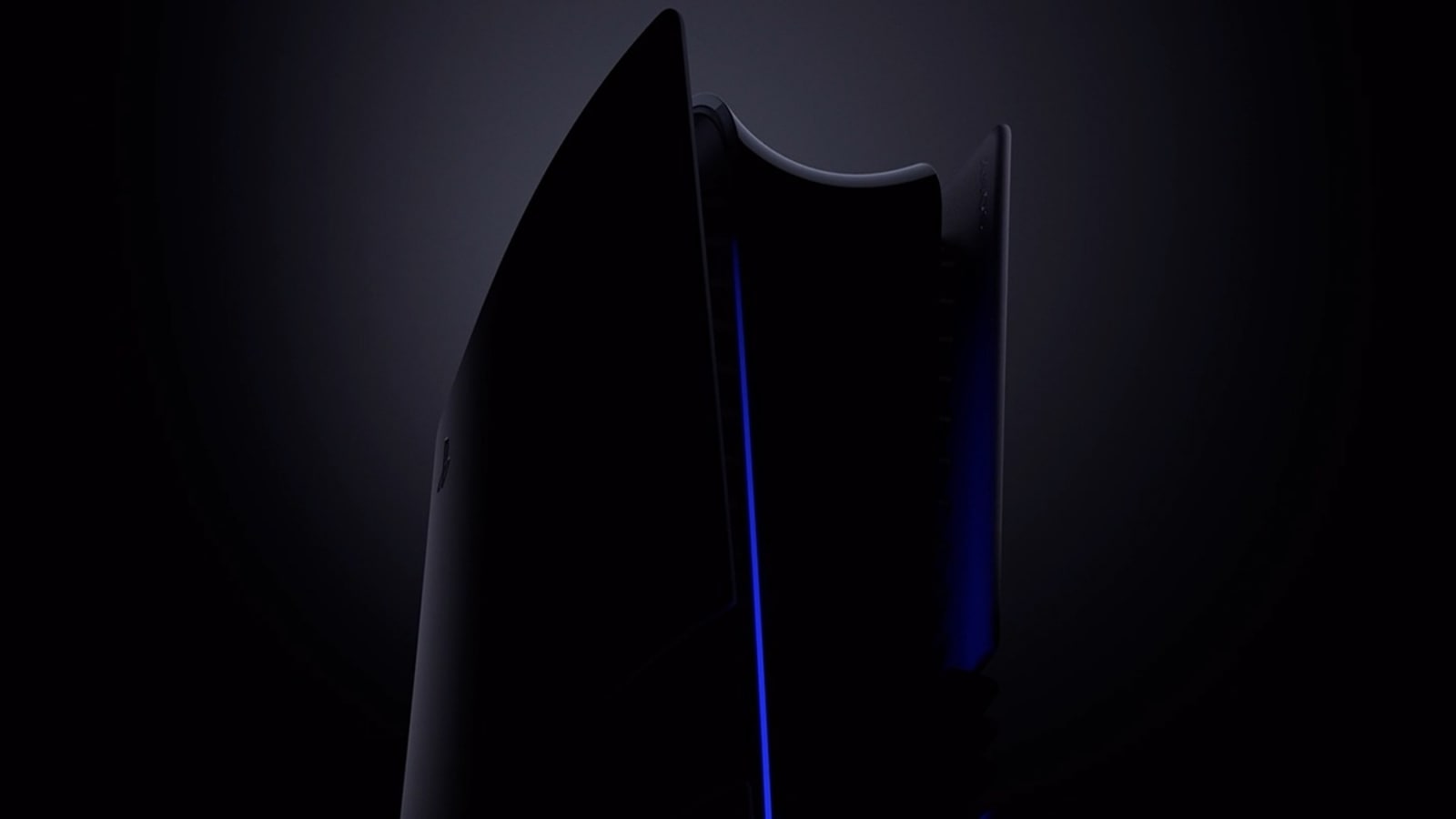Verdict
In the One RS, Insta360 has finally shown why its modular concept is worth sticking with. The upgraded kit allows for better looking video and stills, plus the fact that it’s all backwards compatible with the One R is a huge boon for consumers. While it might not outpace the GoPro Hero 10, the One RS certainly has its merits as an all-in-one device.
Pros
- The modular concept provides a great all-in-one design
- Video and image quality is (largely) excellent
- Fast file transmission
- Lots of tutorials inside the app
Cons
- The screen is just too small
- FlowState stabilisation can’t compete with GoPro
Availability
- UKRRP: £279.99
- USARRP: $299.99
Introduction
The Insta360 One RS is the GoPro competitor’s second attempt at a modular action camera, but are the improvements worth the investment?
Insta360 was clearly on to something when it released the Insta360 One R in the early, pre-pandemic months of 2020. The action camera took on a modular design, allowing it to offer a 2-in-1 solution that offered linear and 360-degree filming on-the-go.
The modular concept has since been adopted by DJI in the DJI Action 2, and while the GoPro Hero 10 Black isn’t modular in the same sense, the company has released a variety of accessories, or “mods”, that are designed to further enhance the overall experience.
It only makes sense then that Insta360 would continue down the modular path for its second mainline action camera. However, given that there were a handful of issues with the original One R, what exactly has Insta360 done to convince people that the One RS can go toe-to-toe with GoPro? After several weeks of testing, the verdict is in.
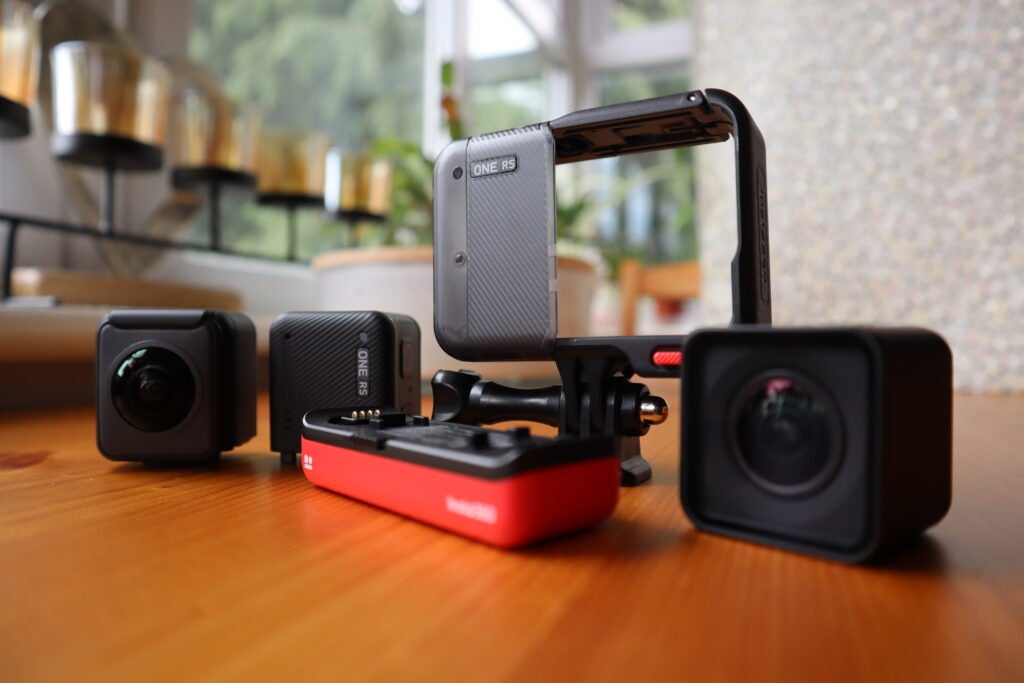
Design
- Modular design remains largely unchanged from the One R
- All new components are backwards compatible
- Quick-release latch on the mounting bracket is a huge help
Unlike the DJI Action 2 which uses magnets in its modular design, the Insta360 One RS relies on physical connections to put its build together. You have the RS Core – an essential requirement for all builds – housing the only display and the chipset that powers the One RS. This can be attached to either the new 4K Boost Lens, the standard 360 Lens, or the new Leica-branded 1-inch 360 Lens.
Each build is then placed on top of the Battery Base, which keeps the One RS chugging along. Note that the whole thing can be dismantled by simply sliding the lock on the base and pulling the two main components apart. It’s an easy process to perform on-the-fly, and it’s definitely the killer feature of the One RS.
It also allows the display to be changed from rear-facing to front-facing, which is particularly handy for those occasions you want to capture and vlog and need to position yourself in a shot. For storage purposes there’s a microSD port hidden away on the RS Core, and a USB-C port right next to it for charging and data transfers.
It’s worth noting that the main upgrades for the Insta360 One RS have been kept to just the RS Core and the 4K Boost Lens – the standard 360 lens remains unchanged, but this allows for the benefit of backwards compatibility. If you have an Insta360 One R to hand then you can upgrade piecemeal to these newer components without needing to fork out for the whole package. This is great – and rare in the world of action cameras – since it shows that Insta360 has no intention of leaving its initial user base in the dust.
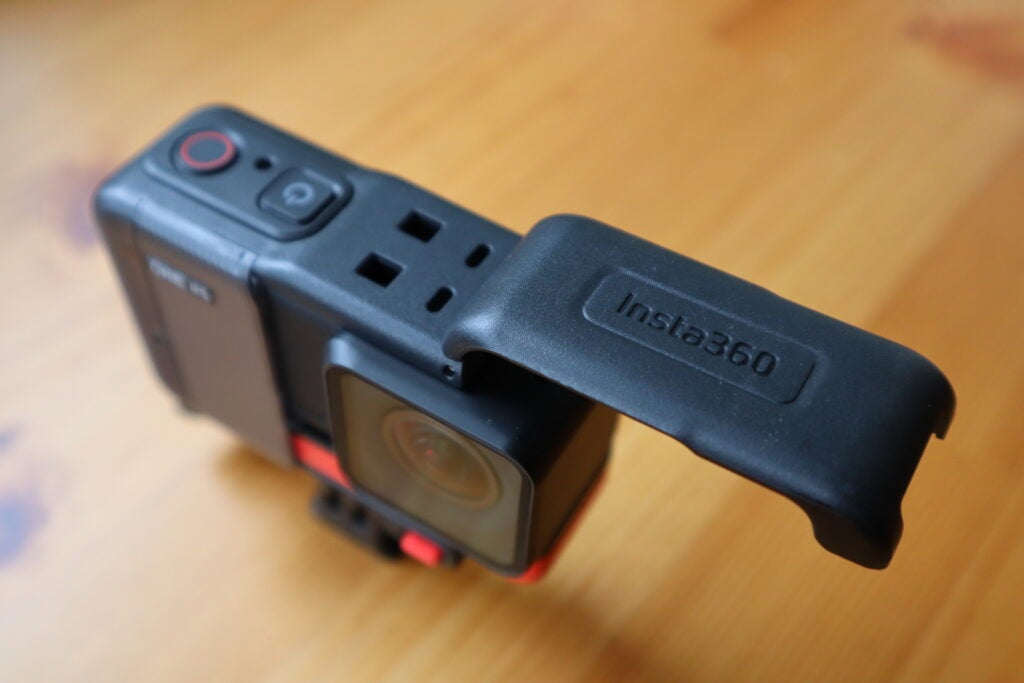
Minor tweaks have also been made to the RS’s mounting bracket: a new windproof cover on the mic and, more important, a quick-release latch. One of the issues with the original One R was the fairly cumbersome process of needing to remove the camera from said bracket to change the setup; but that’s been simplified considerably with the newer design. It’s a small change but one that has a significant impact on the overall ease of use when filming.
Screen and Performance
- Updated core is fast and simple to use
- Main screen is just too small
- Overheating can be a problem on occasion
While I can appreciate the decision not to change the design in any major way, as a means to eliminate any backwards compatibility issues, it does mean that the One RS carries over a major drawback that plagued the One R: the size of the display.
The 1.5-inch display is just too small for most use cases. There isn’t enough space to make out a preview of the shot (even though it’s significantly compressed), and once you add the surrounding information of the user interface, it becomes quite a cramped experience.
I can’t ever recall a time when my fingers simply felt too big to operate a touchscreen, but it’s been a regular occurrence on the One RS. For instance, the UI requires you to tap different corners of the screen to bring up customisation options and the main menu, but these recognised zones are a bit too finicky to navigate on a space that’s small enough already.
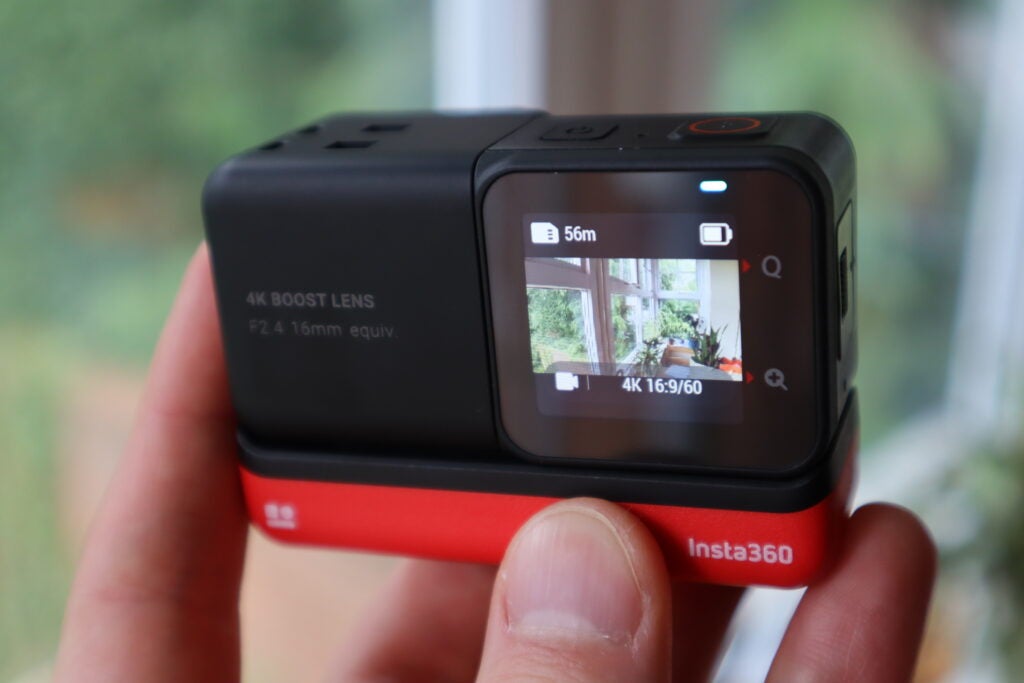
Having just come from reviewing the GoPro Hero 10, which comes with a bright and vivid 2.3-inch display, the adjustment felt even more jarring. Irritatingly, the One RS’s screen is surrounded by a hefty bezel; I can only hope that Insta360 makes use of this wasted space in future to save me from having to squint at the screen.
Beyond this, however, there’s plenty to appreciate; notably the updated processor within the RS Core itself. This more powerful chipset allows for faster Wi-Fi transfers to your smartphone – 50% faster, if Insta360 is to be believed. While it’s tricky to pinpoint that metric exactly, I did notice impressive speeds when transferring files; in some instances it felt like I spent barely any time waiting at all. Pair that with the fact that the UI itself is super-smooth, to the point that I never encountered any slowdown, and the RS One feels like it’s making the same strides as the GoPro Hero 10 for closing the gap between smartphones and action cameras in the performance department.
One thing to bear in mind is that the Insta360 One RS can succumb to overheating in certain environments. Pushing the camera to its limits, I was able to record 22 minutes of uninterrupted video before the camera had to stop to take a breather. In regular use, this was less of an issue since I’d only be shooting for a few minutes at a time. Nevertheless, it’s worth bearing in mind.
Video and Image Quality
- Noticeable improvement to video and stills
- 6K widescreen mode is beautiful to look at
- Companion app includes tons of useful tutorials
For the Hero 10, GoPro made the decision to go all-in on upping the frame rate capture options; but in the One RS, Insta360 takes a different direction, opting instead to improve upon colour accuracy and stills resolution.
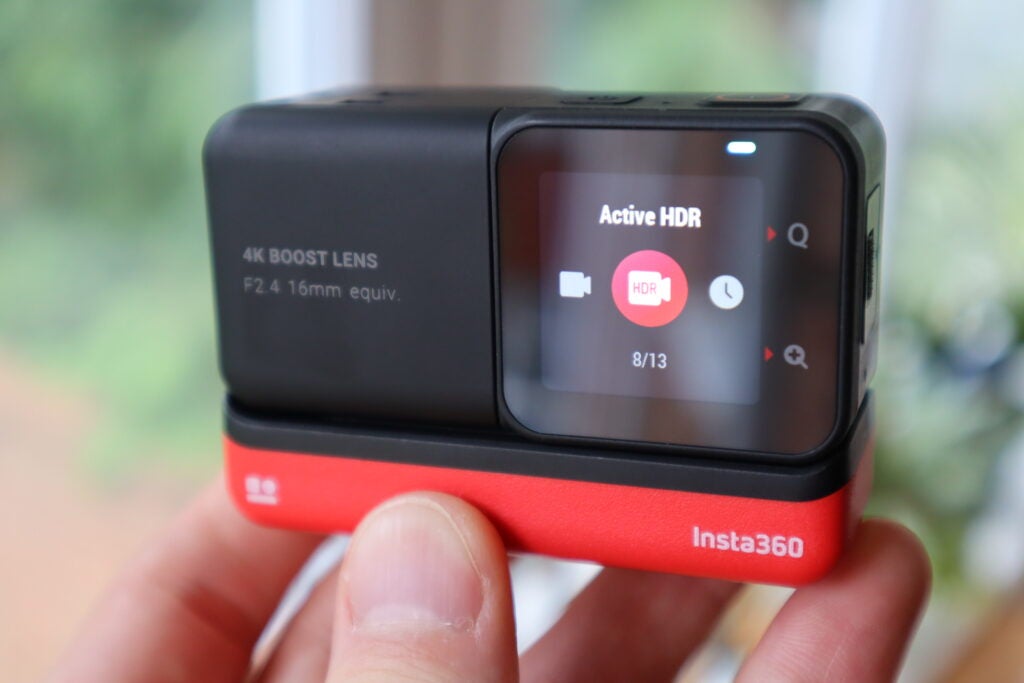
The 4K Boost Lens now houses a ½ sensor that trumps the smaller 1/2.3 used in the One R. While fans upgrading from the One R will notice the difference the most, I must say that I was impressed by the level of colour captured by the new lens. Trees and patches of green grass display tremendous contrast, and even when walking towards the sun, the Boost Lens was still able to capture the sky without it being completely blown out.
Unfortunately, the same can’t be said for the camera’s Night mode. To the One RS’s credit, I experienced the same issue with the GoPro Hero 10. The inability to match high-end smartphones for night time photography appears to be a common theme across action cameras right now.
The larger sensor is only one of the key upgrades to the 4K Boost Lens, however, making a leap from a humble 12-megapixel stills capture to a whopping 48 megapixels. With such a huge jump over the previous tech, the improvements are immediately noticeable.
Well-lit scenes are punchy, with plenty of detail captured in wide-angle shots. High-end phones such as the iPhone 13 Pro still come out on top for portrait shots, in part as a result of its terrific bokeh effect. Nevertheless, the One RS can more than hold its own with the type of jaw-dropping landscape shots for which you’d typically use such a camera.
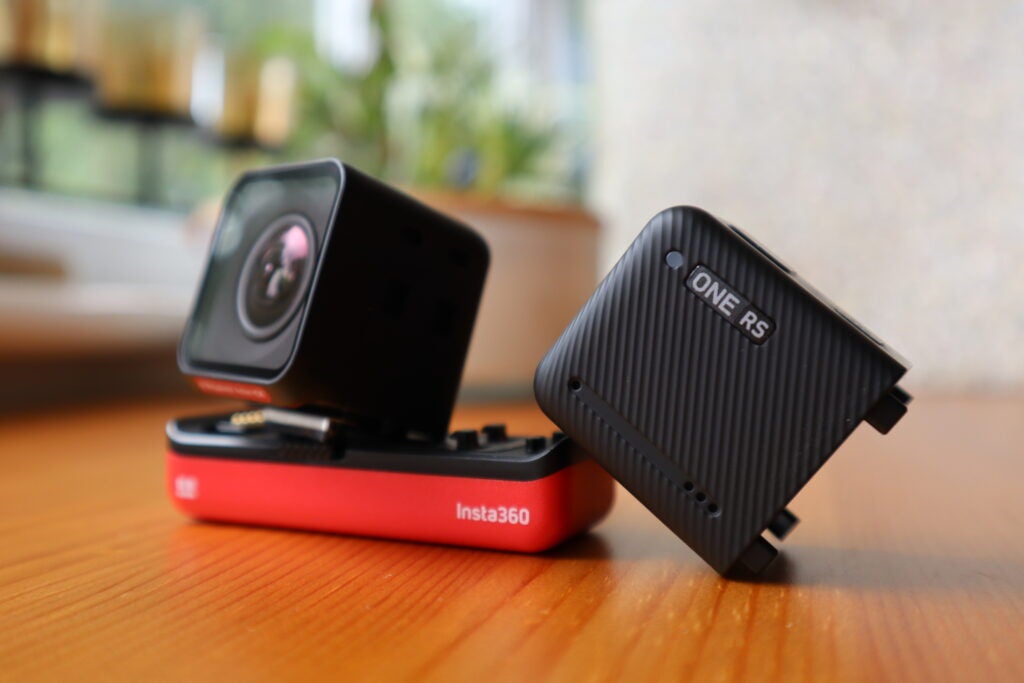
While the larger sensor and the increased megapixel count are easily the One RS’s flagship features, there are a few more improvements to be discovered on delving deeper into its mechanics. It’s now possible to utilise a 2.7x digital zoom during filming, although as with any digital zoom, it’s a feature I tend to steer clear unless I want to deal with grainy footage later on.
What’s more impressive is the inclusion of an Active HDR mode alongside 6K Widescreen capture. The former, as its name implies, takes the concept of HDR playback (which optimises colour on-screen) and applies it during filming for the same effect, resulting in saturated colours that really pop on-screen. The 6K Widescreen mode, on the other hand, will be welcomed by anyone who wants to slow the action down a bit, recording some cinematic shots that look great as part of a vlog.
Audio quality on the improved mic array is fairly solid. The One RS does a decent job of honing in on your voice against wind and background noise, but performance still doesn’t quite compare to the quality you can achieve with a dedicated mic in tow.
When it comes to editing, there are two options: the Insta360 Studio and the Insta360 app. For an in-depth experience (and, as a necessity for 6K footage and high-res photos), the Insta360 Studio is comparable to more professional desktop editing software, but it doesn’t become too bogged down in settings to the point where it will put off newcomers.
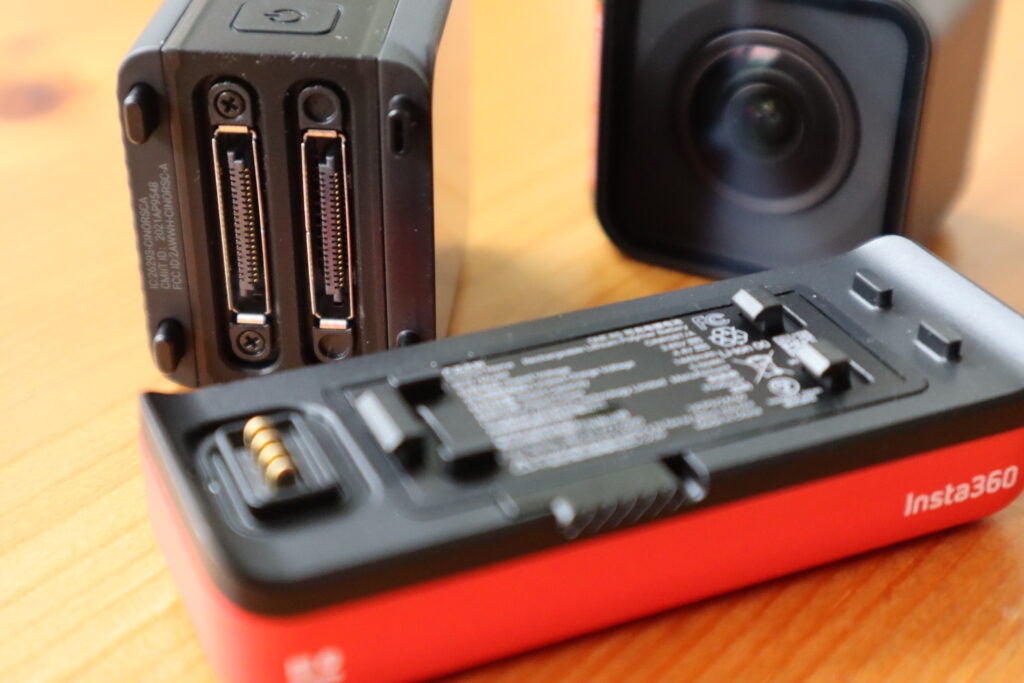
For the most part, however, you’ll be spending time in the Insta360 app. On top of its editing suite, you can view a live preview of your camera feed, videos that other Insta360 users have shot and, better yet, detailed instructions on how you can achieve different visual effects with the One RS.
It’s a great place to start if you have no real experience with action cameras, and it’s something that I’d love to see on the competing GoPro app. With that said, however, I don’t think that the Insta360 app is as refined as GoPro’s offering, but it’s hardly a major drop in quality.
Stabilisation and Battery Life
- FlowState is good, but not as good as GoPro’s HyperSmooth
- Upgraded battery pack over the One R
- Expect roughly an hour of footage per charge
In an effort to keep up with GoPro’s stellar HyperSmooth stabilisation software, the Insta360 One RS delivers FlowState stabilisation, which is applied through the camera itself while filming, rather than post capture.
Footage produced by the One RS is certainly smooth, particularly when filming to-camera segments. However, having just come from the GoPro Hero 10, FlowState still has some way to go before it reaches the heights of HyperSmooth. For example, Hyperlapse videos don’t carry the same level of smooth motion that the Hero 10 can deliver – this is worth bearing in mind if top-tier stabilisation is a priority for you.
In terms of longevity, the battery pack has been updated to a unit bringing a 1445mAh capacity – but what does that mean in real-world terms? Well, after roughly 22 minutes of continuous filming at 4K, the battery had dropped from 100% to 75%. This means that you should be able to get roughly an hour of footage from a single charge. This is fine for your average vlog, but for anything more demanding, I’d recommend picking up a spare battery.
Latest deals
Should you buy it?
You want a solid all-in-one camera: As an action camera that can do a bit of everything, the Insta360 One RS is a great option. Newcomers will find it easy to get to grips with, while the feature set is wide enough that pros will certainly appreciate the variety of what’s on offer.
You want the absolute best action camera: When it comes to linear 2D video, the GoPro Hero 10 still beats the One RS for quality and stabilisation, meaning that its appeal lies mostly in its versatility above anything else.
Final Thoughts
As an upgrade to the One R, the Insta360 One RS is an excellent device. The improved picture, audio and image quality are appreciated, and the faster processor prevents the camera from ever feeling sluggish. Above all, the One RS succeeds in being a competent action camera with an extensive toolkit – the ability to jump between linear and 3D video in just a few moments is a huge boon, not only in terms of space in your camera bag, but on your wallet, too, saving you from having to buy two separate cameras.
Unfortunately, the One RS has fallen into the same trap as any jack-of-all-trades device, in that it ends up being a master of none – which, against the terrific GoPro Hero 10, prevents it from being top dog. Simply put, if you want versatility then the One RS is easy to recommend, but for those looking for the best stabilisation and video quality possible, the Hero 10 is the better buy.
How we test
We thoroughly test every action camera we review. We’ll always tell you what we find and we never, ever, accept money to review a product.
FAQs
Yes, you can use the newer components of the RS, such as the 4K Boost Lens and RS Core, with the older components of the One R.
Yes, the pre-existing 1-inch Wide Angle sensor co-engineered with Leica does work with the One RS unit.
The Insta360 app is available on the Apple App Store, allowing any compatible iPhone to connect to it.
Sustainability
TrustedReviews’ holds the fact that global warming is not a myth as a core value and will continuously endeavor to help protect our planet from harm in its business practices.
As part of this mission, whenever we review a product we send the company a series of questions to help us gauge and make transparent the impact the device has on the environment.
We currently haven’t received answers to the questions on this product, but will update this page the moment we do. You can see a detailed breakdown of the questions we ask and why in our sustainability info page.








